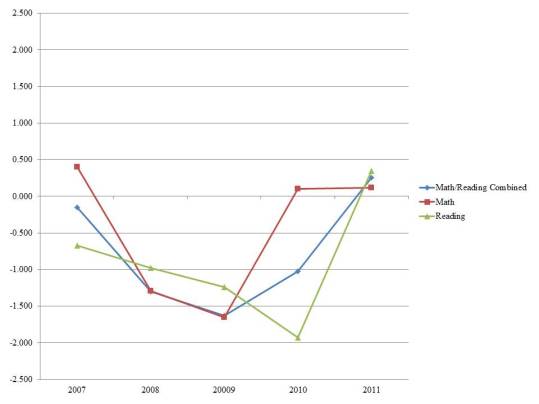As Austin-area readers know, the Austin school board decided to hand over Allan elementary school to IDEA Charter Schools based in the Rio Grande Valley. This decision was based partially on the relatively poor performance on the state mandated Texas Assessment of Knowledge and Skills at Allan (although other East Side elementary schools had worse performance histories).
This decision was made in December 2011, a full 6 months after students completed the 2011 TAKS testing and at least 5 full months after the state released student-level data.
Now, given that AISD has some top-notch researchers, one would have suspected that AISD would have had internal researchers examine the student growth at Allan relative to other AISD schools and schools across the state after controlling for student demographics, school size, etcetera. At the very least, one would have though the district would have hired some outside consultants to examine all of the relevant information about the schools before making such a decision. They did not do this either other than hire a physics professor with no training in research methodology and who does not believe in any type of statistical analyses that controls for student background characteristics. The physics professor did not have access to student-level data (the district could have provided him the data) and, evidently, no one in AISD ran any statistical analysis to determine the academic trajectory of Allan elementary.
The Texas Comptroller hires some statistical consultants with a great wealth of experience and expertise to create growth estimates in math, reading, and math/reading combined for all schools in Texas. This data was released within the past few months and I just got around to looking at it for another project. And what did that data tell us about Allan?
The data shows that Allan had made some pretty solid growth in math during 2009-10 and made some STELLAR growth in reading during 2010-11. The results are z-scores of student GROWTH. Negative numbers indicate growth that was below the state average and positive numbers indicate growth that was above the state average. The further the score is from zero, the worse the score (if negative) or the better the score (if positive).
Did IDEA Academy have greater gains? Most definitely. But that is not the point.* There will always be schools that outperform or under-perform other schools. What is important is that Allan was making PROGRESS–indeed, making pretty significant progress.
Why would the superintendent and school board throw a school showing such improvement under the bus?
Shouldn’t the superintendent and school board have recognized this positive trend and rewarded the educators at the school and supported them to make further growth?
Or were there other reasons for why a charter operator that will remove democratic control of a local school?
—————————————————-
The FAST methodology focuses only on students taking a regular TAKS test (as opposed to special needs students who take an alternate for modified form of the test), does not control for peer effects, and does not control for the systematic loss of students that might advantage or disadvantage a particular school.

Toni Rayner, EMHS Parent
October 16, 2012
Thanks! Did you check the info for the OTHER stabbed in the back school: Eastside Memorial HS?